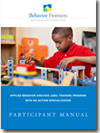The content of Behavior Frontiers Applied Behavior Analysis (ABA) Training Program with an Autism Specialization is listed in 15 Units below. Those interested in learning more about each topic can click on each unit to view a video preview from that unit. Once a participant has taken either a seminar or the online training, then they may access this page to view full length videos for 1-year.
Training Manual
 Registered participants can print this comprehensive, 48-page training manual, which can be used to follow along
and take notes in while watching the videos.
Registered participants can print this comprehensive, 48-page training manual, which can be used to follow along
and take notes in while watching the videos.
>> Download Sample Training Manual for Unit 1: Autistic Disorder.
Data Sheets
Participants may also download these helpful forms to use for training and in practice.
- ABC Narrative Data Sheet
- DTT Data Sheet
- DTT Graph
- DTT Summary Sheet
- Duration Data Sheet
- Event Recording Data Sheet
- Lesson Checklist
- Naturalistic Teaching Data Sheet
- Partial-Interval Recording Data Sheet
- Partial-Interval Recording Graph
- Partial-Interval Recording Summary Sheet
- Task Analysis Data Sheet




